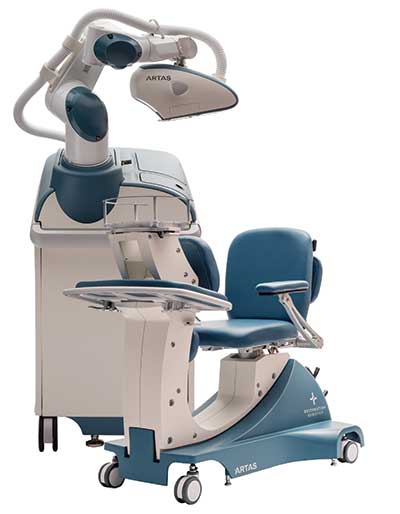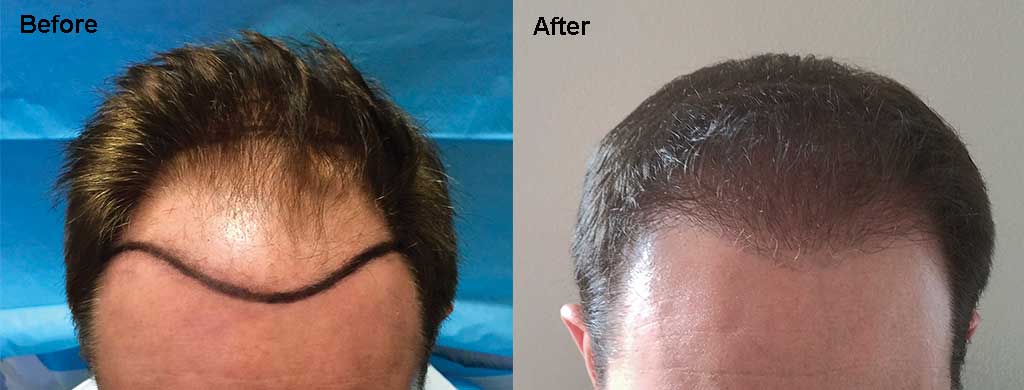“God helps those who help themselves.” —Algernon Sidney (and Dolly Parton, et al.)
There is something to be said in favor of doing what you love. No matter how hard the work is, or how many hours or years, you spend doing it, time just seems to stand still. Every day is an exciting opportunity to learn something new, challenge yourself to do better, and enjoy life to the fullest. When you do what you love, you never think of retirement, let alone growing older, that is until you look in the mirror one day and you don’t recognize the person looking back at you. This is exactly what happened to myself about 12 years ago. The perpetual 30-something me suddenly seemed to have a lot less hair.
That same day I made an appointment for a consultation at Hairclub in New York City. When my taxi pulled up to their center in midtown Manhattan, I put on my Raybans and dashed into the building. Confident that no one had recognized me, I got into the elevator and headed upstairs. The consultation went well and everyone made me feel comfortable. They explained all the different options available, including my preference, hair transplantation. I then met with the doctor who would be performing the surgery, and his assistant showed me photos of the procedure. The results from the after photos looked great, but I was not ready to go under the knife. I decided to live with my thinning hair until I found the right solution for me.
Fast forward ten years. Having pretty much ignored my receding hairline by combing my hair forward, and hoping the wind didn’t blow stronger than 2 mph, I went about my life much as before. I didn’t think about getting older, because I didn’t feel any older. I was busy discovering exciting places where people could travel, and sharing these wonderful destinations with the readers of Passport magazine.
Then, one day on a plane from Miami to New York, I saw an ad in the in-flight magazine for Ziering Medical (www.zieringmedical.com) and their Robotic follicular unit extraction (FUE) hair transplants. I was intrigued by what they were offering: single-hair extractions from the back of the head transplanted to the areas where your hair has receded or is thinning. They promised no visible scarring and the opportunity to return to work a few days after the procedure was completed. I studied the ad and knew this was what I had been waiting for. I called Ziering the next day and made an appointment for a consultation.
A few days later, I met Dr. Ziering and his office coordinator, Annabel, at the New York City office on Central Park South. It was a busy morning as Dr. Ziering had two clients he was working on simultaneously.
I had done some research into hair transplant procedures, so I basically knew what I was looking for. Annabel showed me before and after photos and gave me a rundown of what to expect regarding healing time and results. She showed me photos of the donor area in the back of the head of one patient, and I was quite impressed at how fast it healed. After three days there is just a little redness. At eight days there is no sign that any procedure has been performed. (Later I learned that this patient had 1,100 grafts. My procedure involved 2,500 grafts and covered a lot more donor area on the back, as well as the sides, of my head.)
Annabel asked me what I hoped to achieve with a hair transplant, and I told her that I wanted to cover the balding areas and restore my nonexistent hairline. She asked what type of procedure I preferred and I told her the Robotic FUE procedure because it is the least invasive and doesn’t require cutting and sutures.
When Dr. Ziering joined us in the consultation room he marked my head with a black marker indicating where he would implant the grafts and how many would be needed to ensure the hair coverage I desired. He showed me his concept, and I told him what I would like. We went back and forth a couple of times adjusting the hairline so that it would look natural, but also cover the area where currently there was no, or little, hair.
We then discussed when the best time would be to have the procedure. I had a good feeling about Dr. Ziering and I found it easy to talk with him. He’s a busy man, and this is evident by the fact that he was working on his birthday! “I must love what I do if this is where I want to be on my birthday,” he said.
I had about six weeks to prepare myself physically and emotionally for the hair transplant procedure. I was told that it would take place over two days. Day one would entail three hours and Dr. Ziering would “mark” my head and the hairline area and create the holes where the new follicles would be implanted. This seemed simple enough. On day two the hairs from my donor area would be extracted by the Artas Robot. I assumed this would take about three hours.
During the weeks and days leading up to the hair transplant, I was concerned about getting sick and having to postpone the procedure. As I was a little nervous about what I was getting myself into, I knew that if that I cancelled my scheduled appointment I would never follow through with the procedure.
I worked out at the gym every day to be in good physical shape, and I meditated, visualizing an easy a successful hair transplant. The one image that kept coming back to my mind, however, was that of the robot. What if something went wrong? The machine would be working on my head, and right below my scalp was my brain! What if the robot went wild and starting looking for grey matter instead of hair follicles? I took a deep breath and reassured myself that the robot was foolproof and fail-safe, and that everyone working with it knew what they were doing.

On day one of the procedure, I arrived at Ziering Medical at 3 P .M. to do a short video interview with their pubic relations representative before the doctor “marked” my new hairline. Being a journalist, I was focused more on doing my job than being a patient, so I wasn’t expecting what happened next.
A young doctor from the Hamptons was there along with Doctor Ziering, an associate surgeon, and about four assistants. The doctor from the Hamptons began injecting my skull with local anesthesia. Each shot stung, and I thought there would be just a couple of them. However, after 20 shots and more to still be administered, I knew I was in for some major work. After about ten minutes, my head felt like a bowling ball and I wondered if it would roll off my neck.
Next up, Doctor Ziering used a small tool to create a new hairline and the holes where the hair follicles would be inserted the next day. This part of the procedure seemed to take less than an hour, even though the doctor created 2,503 holes. As he worked on my head, I could hear each and every puncture. There was no pain involved, except a minor sting toward the end, which was quickly rectified with more local anesthesia. The doctors told stories as they worked and made me feel comfortable. The hardest part of this procedure was receiving the local anesthesia. Because I don’t like injections and needles, this made me nervous and my legs began to twitch. One of the associate surgeons keep encouraging me to breathe deeply and helped me through my case of the jitters.
After the procedure was done, they wrapped my head in saline pads and a medical cap and sent me home. I was given an antibiotic to prevent infection, Prednisone to prevent swelling, and Tylenol with codeine in case there was any pain. I put a baseball cap over the medical wrap and asked the doorman of the building to hail a cab for me. Feeling like a Hollywood star trying to avoid the paparazzi, I walked from the building on Central Park South, got into the cab, and headed home.
That night (and for the next five nights), I was told to sleep on my back at a 45degree angle to prevent bleeding and swelling. I had a big dinner and fell asleep early. I didn’t have any pain, but I took one regular strength Tylenol just in case.
Day two of the procedure began with a 6 A.M. wakeup call! Not being a morning person this is not something I looked forward to. I was told to have a full breakfast and be at the office by 7:30. When I got there they took me into the room where the Artas Robotic Hair Transplant machine was warming up for the procedure. An associate surgeon and three women assisted during the process. One worked the robot (under Dr. Ziering’s supervision), and the other two made sure I was positioned properly in the chair so Arty could extract the individual follicles from the back and sides of my head. Three other women were there to take the donor follicles, separate them according to size, and get them ready for transplantation later that day.
From about 8:30 A.M. until 1:30 P .M. the robot carefully extracted the follicles from my head. The copious amounts of local anesthesia injected into my head made sure there was no pain. The hum of the robot was rather hypnotic (the 5 mg of valium also helped). Every few minutes the robotic arm was taken up so I could move my head and stretch my body. During this time I could drink something or quickly check my e-mail if I wanted. We all took a break for lunch, which they will provide. However, I brought my own (Yogurt, watermelon, and a sandwich). After lunch, we continued with the robot until about 5 P.M. when an associate surgeon manually extracted the remaining follicles. All in all, the robot extracted about 2,000 grafts and the associate surgeon feathered the donor area using manual FUE for a total of about 2,500 grafts.
Around 7 P.M. I was giving an injection in my arm to make sure I felt no pain during the implantation process. This injection was the most painful part of the procedure. It wasn’t the prick of the needle that hurt, it was the drug going into my arm that caused the pain. (Note: The drug injected was Toradol, which is a nonsteroidal anti-inflammatory drug. The medication is thick so it is more painful at time of injection. FYI the medication can be administered orally, however it is not as effective and patients aren’t as comfortable throughout the procedure.)
The implantation part of the procedure is quick and easy. The three women who organized and prepared the follicles also implanted them. They worked on the crown and front of my head simultaneously and completed everything in about an hour to 90 minutes.
Afterward, they put a bandage on my head and sent me home, telling me the bandage could come off before bed that night.
During the first week of the post-op period, I had to be very careful to avoid infection and bleeding. Dr. Ziering and his staff provided me with a detailed list of guidelines to help me through the post-op period. I had discontinued the use of any vitamin supplements and aspirin the week before, and did not drink any alcohol a week prior to and following the procedure. I also had to continue to sleep on an angle with my head raised for three nights to help avoid swelling. There was some bleeding and oozing during the first week, but that subsided as my scalp began to heal. Strenuous physical activity is not recommended for ten days after the surgery, but after a week I couldn’t wait to get back to the gym! What concerned me, however, was that my head felt numb and it wasn’t going away. I was told that this is normal and can last for 12 months. In my case the numbness grew less and less and stopped after four months.
It took about three weeks for the pink skin where the new hairline is to be less noticeable, and the only itching or numbness I felt was in the donor area at the back of the head. I was told I could color my hair at four weeks, but I decided wait at least to five weeks.
Because people could see the outline of the new hairline before the transplanted hair grew in, I wore a hat whenever I went out and while at the office. One positive aspect of this is that I seem to attract a lot of people who think I look sexy in a hat.

I was told during the initial consultation that the most painful part of having a hair transplant is waiting for your hair to fully grow in and look natural. My new hair started to grow and become visible after a few months, but it took about a year for the full results to be revealed.
My mother, who has thinning hair due to the medication she has to take, encouraged me to have the procedure done. She is 87 and when she wears one of her wigs she looks and feels much younger. When I originally told her I was thinking of getting a hair transplant she told me without hesitation: “do it!”
A year later, while having dinner one night, she was the first to notice the difference. “You have a nice head of hair now,” she told me. Then she asked: “How long will it last?” I told her that the transplanted hair is permanent. She looked at me again and smiled.
At a cost between $15,000–$25,000, a FUE hair transplant like the one I had is an investment in time and money that you must be willing to make. I am happy with the results and quite amazed by the before and after photos.
When I met with Dr. Ziering 18 months after the procedure, he was quite impressed to see the results of his work. He examined the donor area and there were no visible scars or any evidence that I had a transplant. The new hair looks natural and I feel comfortable doing everything I love: swimming, hiking, dancing, and dining al fresco.
As Dr. Ziering looked me over one more time he said he was very proud of the results of this one procedure, adding: “we could increase the density with another procedure.”
I asked him how many people have two procedures and he said “quite a few.” I thanked him again for all that he had done and said, “once is enough for me.”


